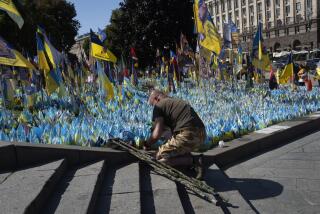An artist confronts the anguish, and hope, of Ukraine
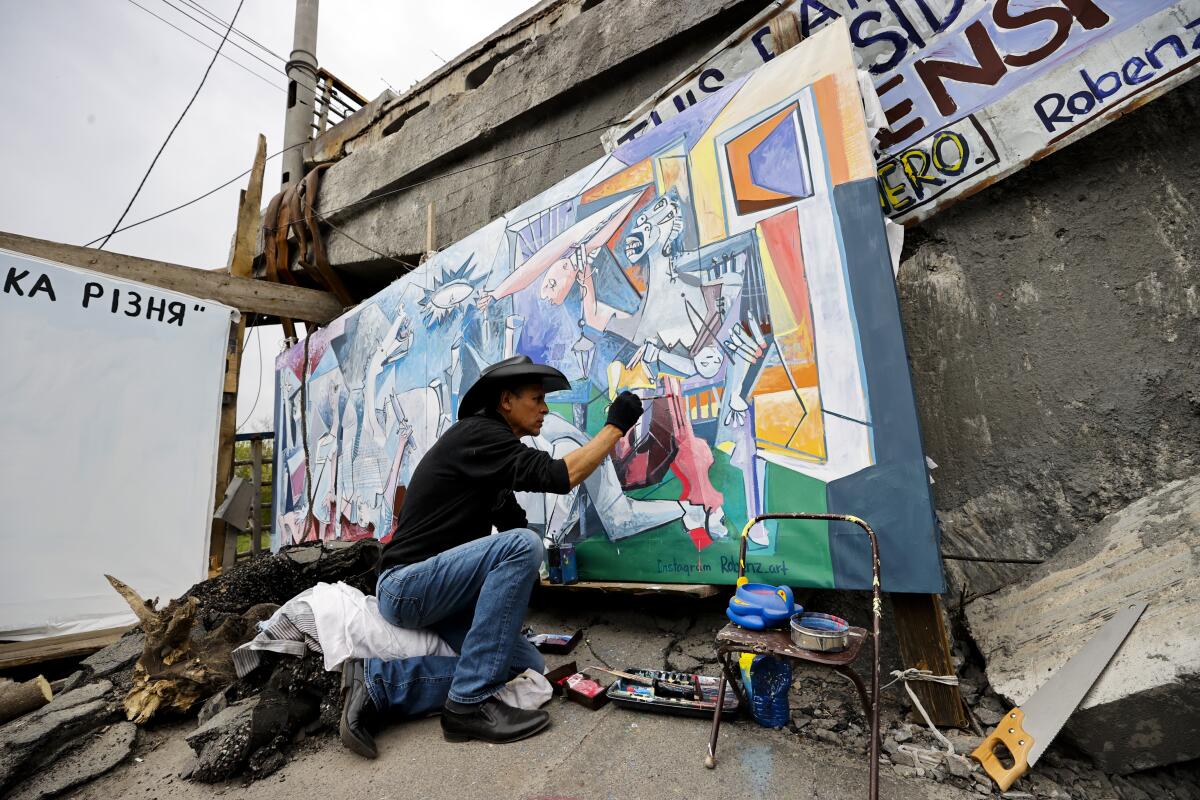
IRPIN, Ukraine — As Russian forces were advancing on Kyiv in late February, the Ukrainian military tried to stall them by blowing up a highway bridge just north of the capital.
It may have helped. But it also slowed the exodus of civilians.
For days, crowds fearing Russian artillery sheltered under the ruins of the bridge as snow swirled around them and Ukrainian soldiers helped people — some with children or elderly or disabled citizens on their backs — traverse the icy Irpin River on a series of planks.
Like millions of people across the globe, Roberto Marquez watched television coverage of the ordeal.
“It really touched me,” recalled Marquez, who was in his native Mexico at the time. “I figured this is the place for me to work.“
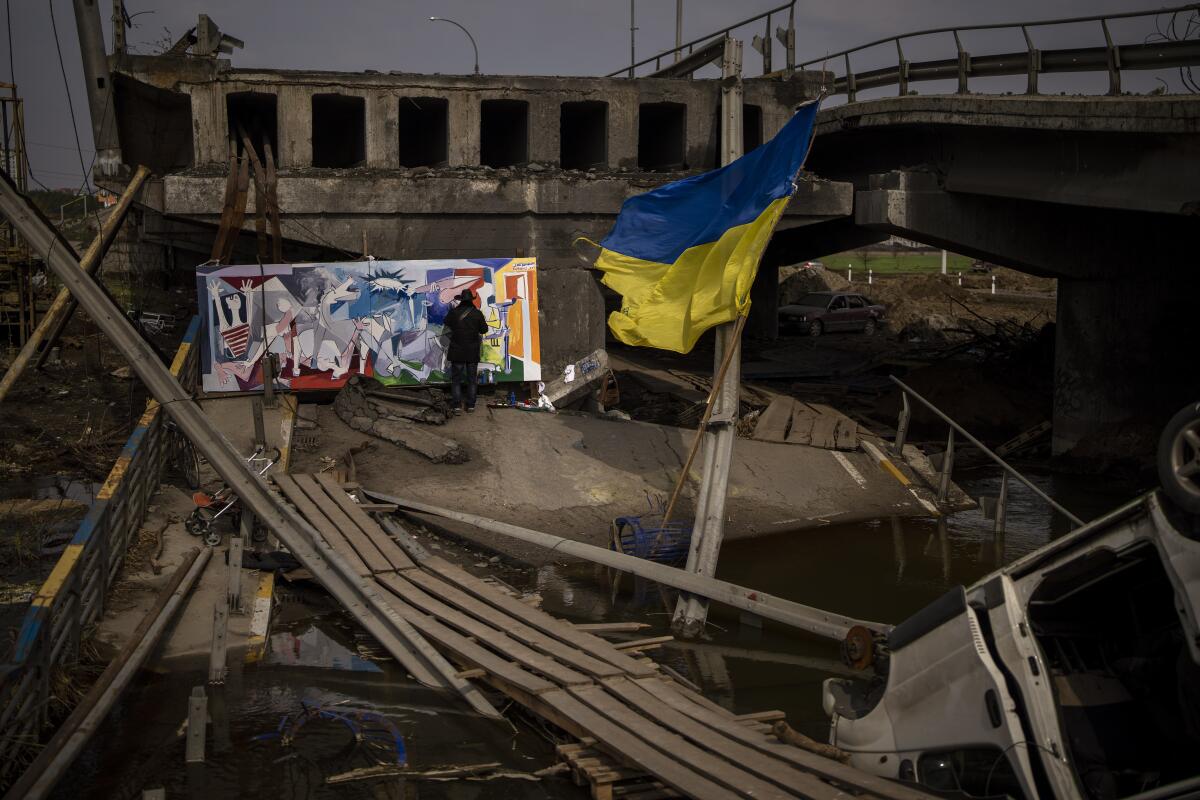
And so Marquez — an artist who views his work as social advocacy — made his way to Poland and then to Kyiv. Once the Russians retreated from their positions around the city in late March, he set up a makeshift, open-air studio in the shadow of the shattered bridge.
With the blessing of Ukrainian officials, he went to work there on a pair of large canvases.
Outfitted in his 10-gallon leather hat and a bandolier holding his brushes, Marquez painted for more than a month as Ukrainian military foot patrols passed by daily on their rounds.
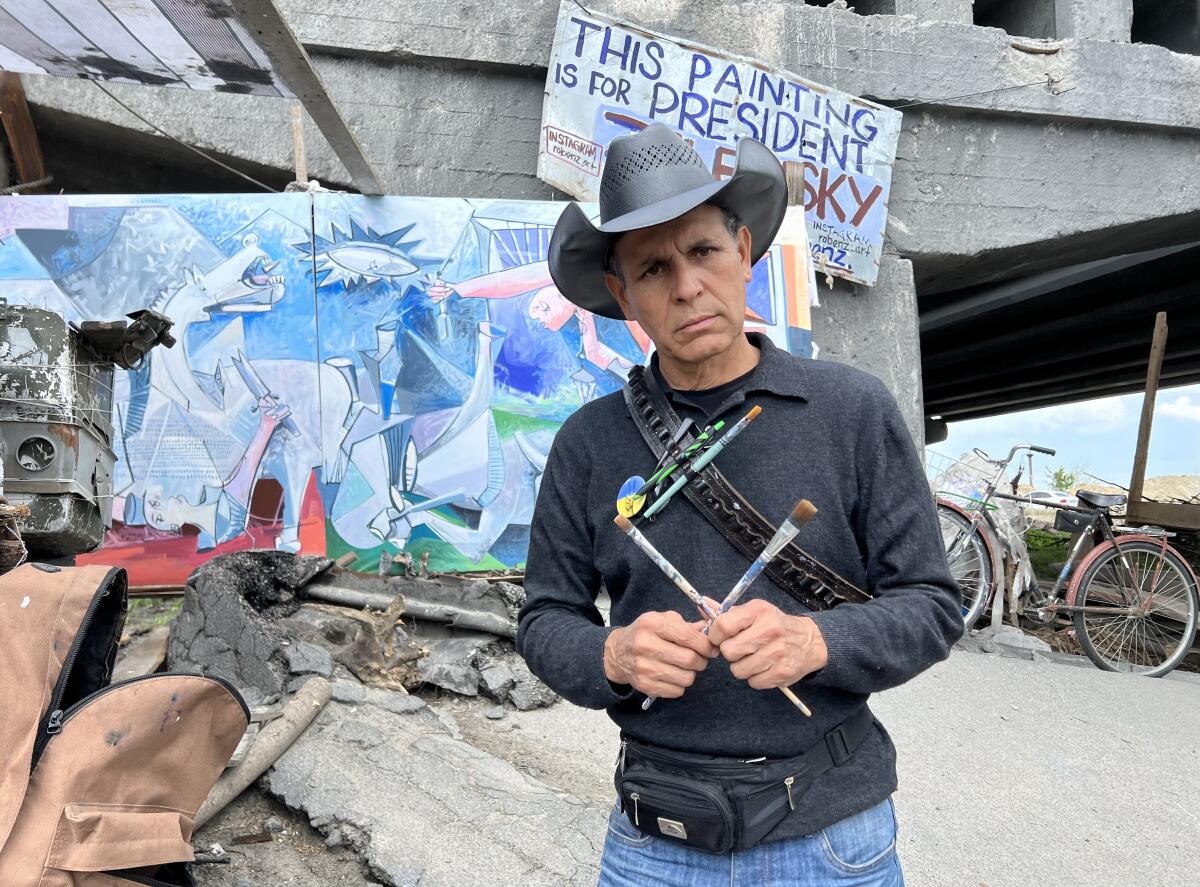
He created two works — one 6 feet by 14 feet, the other 6 feet by 9 feet — both inspired by Pablo Picasso’s “Guernica.”
They depict a pair of signature early events of the war in Ukraine: the dramatic river crossing in Irpin and the discovery of what Ukrainian officials are calling mass murder and war crimes in nearby Bucha and other towns that the Russians had occupied.
With the help of Ukrainian friends, Marquez also crafted wooden crosses, which he planted in the ground next to the rubble of the bridge to mark the escape path and honor the war dead. The idea came from the crosses placed by activists along the U.S.-Mexico border to commemorate migrants who died or disappeared there.
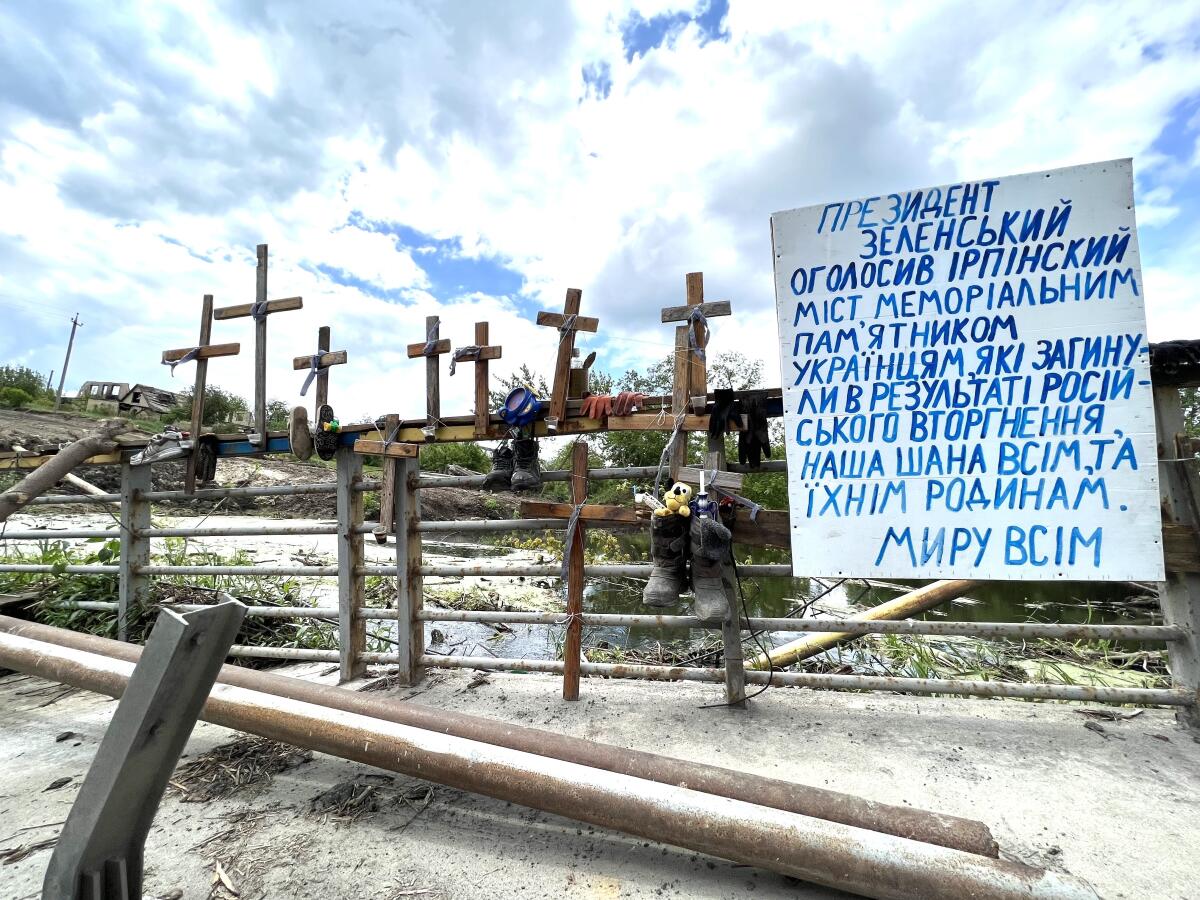
“I’m a person of the border,” said Marquez, 60.
He said he was 15 when he crossed the border illegally from Tijuana and went to work as an agricultural hand in California. As one of millions who acquired legal status through the 1986 U.S. amnesty law, he became a U.S. citizen. He later embarked on a lucrative real estate career in Dallas and had four children.
Marquez turned to art as a sideline in the 1990s. Among his first works was a portrait of his mother as a young girl, painted at a time when she was gravely ill with cancer.
“That was like opening the door to another world,” he said.
His creative run turned to activism during the Trump era when caravans of Central American migrants began heading toward the U.S.-Mexico border. In Tijuana, he unveiled a huge variation of the U.S. flag — one that lacked stars and was meant to dramatize the contribution of immigrants.
He called the work “United States of Immigrants.”
He later created on-site artworks at Black Lives Matter rallies and other national protests. “I want to be exactly where the action is,” he said. “That’s where I get my inspiration.”
Once Marquez arrived in Poland in March, he started painting at the Warsaw train station — a key transit point for refugees — and in the town of Medyka, on the border with Ukraine. He stayed in Poland a few weeks, producing Cubist takes on the refugee influx.
He left a handful of completed works behind, and though he is not sure what happened to all of them, he heard that some are now in the possession of Polish museum officials.
In Ukraine, he set up shop next to the destroyed bridge with the support of the mayors of Irpin and neighboring Bucha, two Kyiv suburbs that are struggling to return to normal after the Russian invasion left widespread death and devastation.
Marquez said he chose the Cubist Picasso motif because “Guernica” — which memorializes the Nazi bombing of the Basque town in Spain and is regarded as one of the great antiwar statements of all time — inevitably draws attention. The look is certainly derivative, but never obscure. For Marquez, the message may trump the aesthetic.
“Every time that I do a project, always the first thing that comes to mind is: What do I need to do to connect to people?” he explained. “I can do something in my own style, but sometimes you lose the audience. ... I can paint a ‘Guernica’ with my eyes closed.”
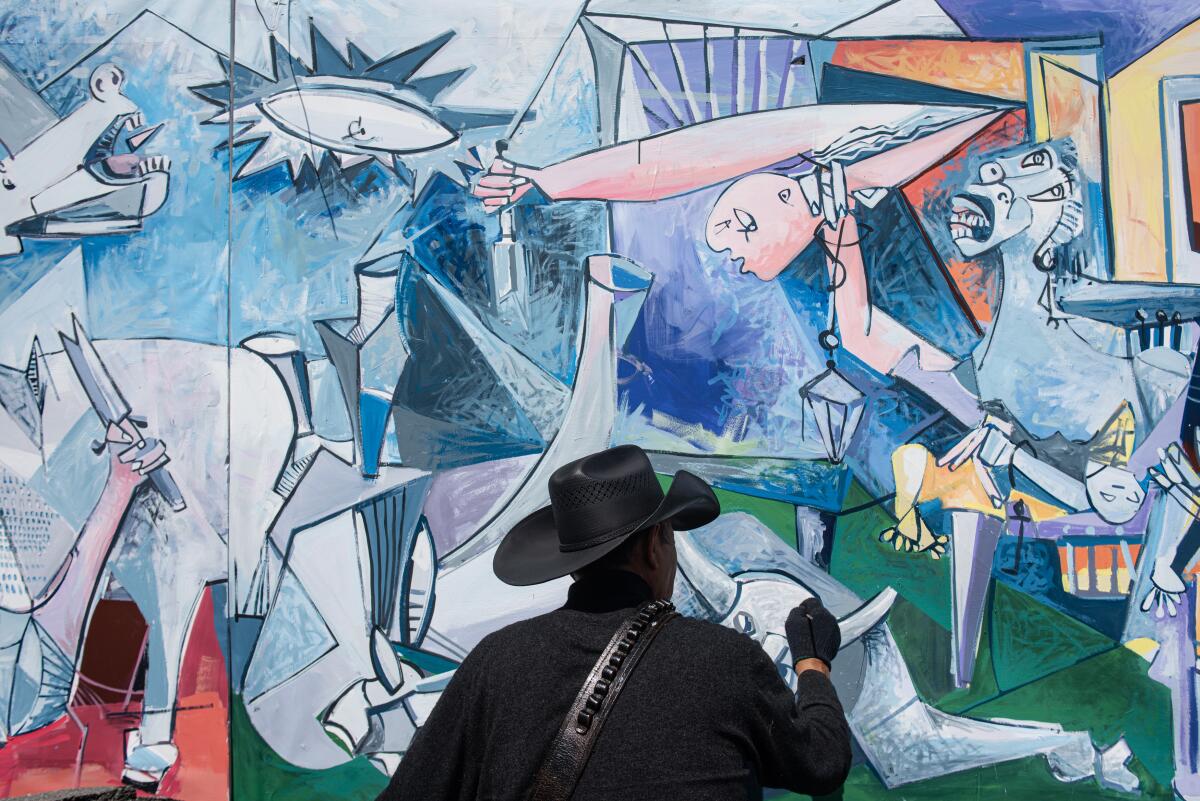
With the Ukrainian flag fluttering overhead, the site has been transformed into a kind of outdoor art installation featuring Marquez’s paintings, the rows of wooden crosses and several handmade signs bearing messages of peace. Also on display is a collection of Russian military gear found abandoned at a nearby town.
President Volodymyr Zelensky has announced plans for the construction of a national monument at the bridge, commemorating all those who braved the journey.
Marquez said he would be pleased if his paintings were incorporated into the final design. “I hope they leave them there as part of the memorial, but I don’t know exactly,” he said. “Whatever they do is fine by me.”
War is still raging across broad swaths of Ukraine, and many civilians are now fleeing conflict in the east and south. But, for the moment, a sense of calm has returned to the capital and its suburbs.
All that remains of the bridge are two giant concrete blocks with protruding strands of rebar. A temporary span allows traffic to cross. An upturned white minivan still sits at the edge of the river. There are few pedestrians these days.
More to Read
Sign up for Essential California
The most important California stories and recommendations in your inbox every morning.
You may occasionally receive promotional content from the Los Angeles Times.

